For the first decades of the college, faculty carried not only teaching duties but also most administrative tasks as well. They took on being bursar and librarian, registrar and supervisor of buildings and grounds. Over time, the college began hiring staff to relieve faculty of extra duties but the transition went slowly.
In 1920, the college created the first Dean of Student position and it was filled by a faculty member. Mark Edgar Sentelle, Davidson class of 1894, continued to teach religion and philosophy classes for the 21 years (1920-1941) he served as Dean. Initially, the Student Life office consisted of the Dean and a secretary, Dorothy Finlayson, he shared with the college treasurer. Sentelle joined the faculty in 1903. Fellow professor, Ernest Beaty described his career in the September 1941 Alumni Journal:
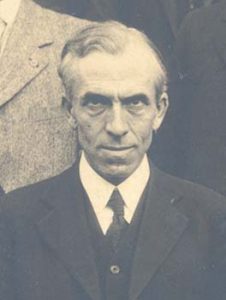
Mark Sentelle in 1922
As a member of the faculty, he soon evidenced such sense of judgment in dealing with men that this special talent was immediately put into use. President Henry Louis Smith (1901-1912) requested Dr. Sentelle to handle student absences, and this he did for some time, drawing up absence regulations under which the College functioned for years. In 1910 President Smith again turned to Dr. Sentelle, asking him to head up a committee on supervision of scholarship. Dr Sentelle soon had in effect regulations which served notice that Davidson College would not give indefinite residence to students who were not keeping up the Davidson standard of work, whether failure to do so were due to an unfortunate lack of preparation or to culpable slothfulness.
Beaty went on to note that it was
natural then, that upon Dr. Sentelle’s election as Dean in 1920, the enforcement of both absence and supervision regulations should be centered in his office. Hence, year after year, the big ‘Doom Book of Absences’ has reposed in the Dean’s office, and excuses of infinite variety have been poured into his ever receptive, but not always ‘acceptive’ ears.
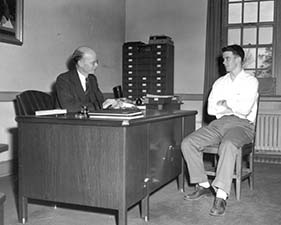
Bailey in 1949 with a student. It is not clear if any of this books on his desk is a “Doom Book of Absences.”
Upon his retirement in 1941, another active faculty member took on the role of Dean of Students. John Crooks Bailey, Davidson class of 1920, continued his courses in Greek and Religion during his 2 tenures as Dean (1941-1954, 1958-1961). The office he inherited had focused heavily on discipline and regulations and had consisted of the Dean and a secretary. Bailey began to interact with the social side to students as well.
By 1941, the college had a YMCA secretary, a new college union, and later a chaplain. Bailey was also a member not only of the honorary fraternities Phi Beta Kappa and Omicron Delta Kappa but of a social fraternity Kappa Alpha. Ernest Beaty deened him qualified to be a dean because of his “unusual alertness in the observation of facts and persons and a marvelous keenness in analyzing them” along with “a fine vein of humor, that saving virtue which makes life attractive” ( and presumably visits to the Dean’s office a little less uncomfortable).
Dean Bailey provides a good example of how his office dealt not only with students but also with their parents. In a 3-page memo to parents and guardians of Davidson Freshman written in August 1960, he included “A Word to Mothers” admonishing them to “let your son and his roommate have the satisfaction of doing their own unpacking unsupervised and let them arrange things in the way they want them. Their arrangement may be different from what yours would be, but they are the ones who will be living there.” He further noted — with underlining,
Our experience leads us to think that most boys are secretly, if not openly, embarrassed when their mothers insist on staying in the dormitory rooms to supervise unpacking and to arrange the rugs, etc.
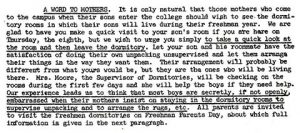
Dean’s warning to mothers.
Presumably, fathers in 1960s were less interested in their offspring’s accommodations.
Serving between Bailey’s years was a familiar Davidson face, Samuel R. Spencer, class of 1940 and future president. Spencer had already served on the faculty in 1941-1943 as a professor of military science. He kept up the dual faculty-dean role by teaching in the history department while Dean.
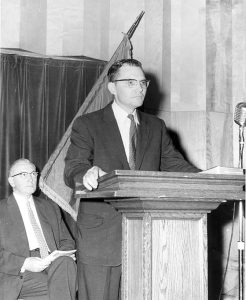
Sam Spencer as Dean of Students with President John Cunningham in the background.
The next Dean of Students broke the mold by not being a Davidson graduate (Furman instead) and not teaching. Instead, Richard Burts (1961-1970) spent his 9 years solely as a dean and then became college registrar from 1970 to 1985. During his tenure, the Dean of Students office added an assistant to the dean and advisor to fraternities, extending the social role of the office.
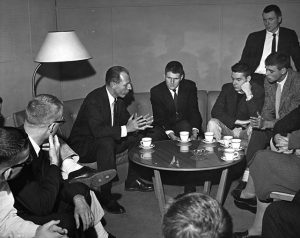
Dean Burts engaging with students
When he started as Dean, all his students looked like the young men in the photo but shortly after his arrival, the first African and then African-American students joined the student body adding the issues of integration to his work.
William Holt Terry, Davidson class of 1954 replaced Burts and added the challenges of co-education to those of integration. In 1977, the office added Sue Ross as the Assistant Dean of Students. Her successor, Paula Moore, hired in 1985 was the first black assistant dean. During his tenure (1971-1994), the Dean of Students office expanded to oversee Residence Life, Careers, College Union, Chaplain’s office, Student Health and Counseling, and Community Service. By 1994, the Student Life had 43 full and part-time staff covering student — and still parental– activities and concerns.
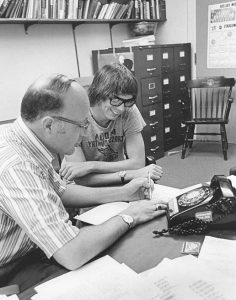
Counseling Will Terry style — well before cell phones and Facebook.
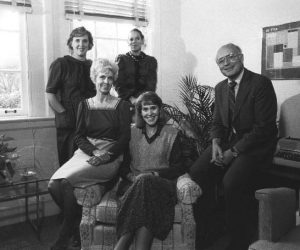
Dean of Students Office -deans and administrative assistants, c1983
Tom Shandley, the most recent Dean of Students came in 1994 and will retire in 2017. Like Will Terry, Shandley has seen the issues Student Life faces expand along with more staff. Mark Sentelle, even as a philosophy professor, likely never dreamed of addressing gender-integrated housing, therapy animals, sexual harassment policies or nutrition guidance. All the deans have met with students over academic pressure, alcohol violations, health concerns, and roommate conflicts. Ironically, even as colleges have stepped back from “in loco parentis” roles, the work of the Dean of Students has expanded. Students face a more complex world and expect that co-curricular activities will enhance the academic experience. Sadly, few records remain for the earliest deans ( the Doom books are long gone) but the records the archives does hold await exploration and discovery. The history of Davidson’s six Deans reveal the changing roles college governance, the changing nature of college students, and the context of college experience in American culture.
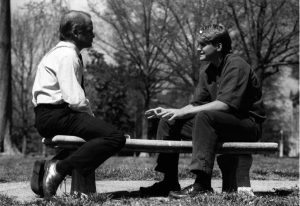
Issues change but face to face meetings remain constant. Tom Shandley with SGA President Warren Buford

Speak Your Mind